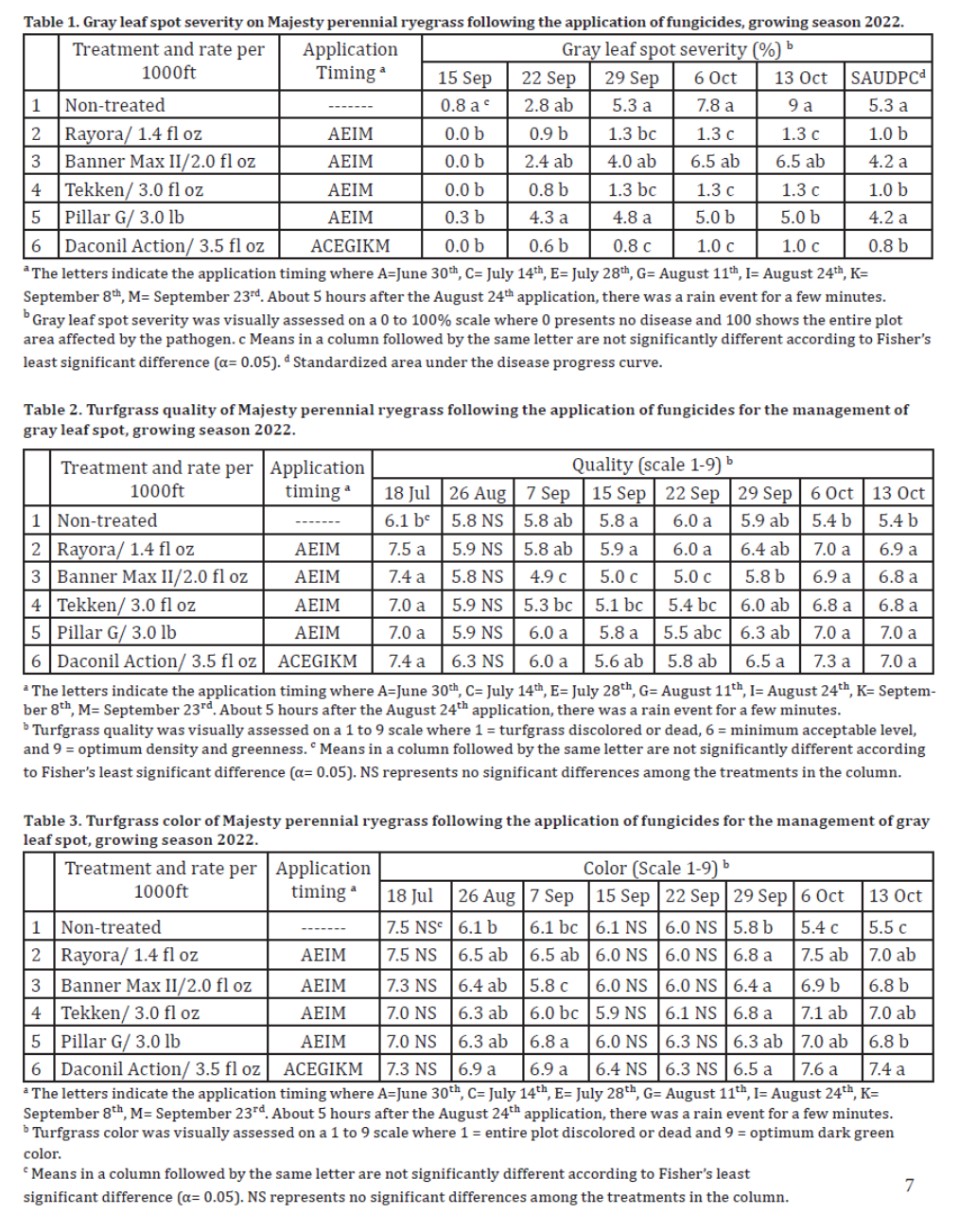Evaluation of fungicides for the management of gray leaf spot (Pyricularia grisea) on perennial ryegrass (Lolium perenne)
Fereshteh Shahoveisi, Department of Plant Sciences and Landscape Architecture, University of Maryland, Co llege Park
llege Park
A field study was carried out at the Paint Branch Turfgrass Facility in College Park, Maryland. Perennial ryegrass cv. Majesty with a 3-inch height of cut was used to test the efficacy of fungicides in the management of gray leaf spot disease caused by Pyricularia grisea. Treatments were applied approximately every 14 or 28 days beginning June 30th, 2022, and concluded on September 23rd, 2022. Non-treated plots were also included as negative controls. A CO2 backpack sprayer equipped with a Teejet AI9508E nozzle was used to spray 2 gal /1000 ft2 fungicides in 3×6 feet plots. A total of four replications and a randomized complete block design were used. Quality and color were measured once a month (on July 18th, August 26th, and September 7th) prior to disease initiation. The plots were inoculated with 4000 spores/ml of P. grisea suspension on September 11th as the disease did not occur naturally. Gray leaf spot disease severity (percentage), quality and color (1-9 scale) were measured every week after disease symptoms appeared on September 15th; the rating was continued until October 13th. Urea fertilizer was applied three times (0.9 lb/ 1000 ft2 on June 6th, 0.5 lb/1000 ft2 on July 11th, and July 25th). Further, plots were sprayed with Prostar® (or Pedigree) and Emerald® fungicides on June 30th, July 13th, July 25th, August 8th, and August 24th for the management of brown patch and dollar spot, respectively. Two herbicide applications were used on July 8th (Three-WayTM Ester) and July 27th (TZoneTM) for the management of broad-leaf weeds. The experiment was concluded on October 13th as the disease severity did not progress. Analysis of variance and Fisher’s least significant difference (LSD) procedure at α= 0.05 were used to compare the treatments in their efficacy in managing gray leaf spot and improving the quality and color of turfgrass. Rank transformations were used for nonparametric data including quality and color.
Among the treatments, non-treated control resulted in the highest disease severity compared to treated plots except on September 22nd where Pillar G had a numerically higher disease severity but it was not significantly different from the non-treated control. Overall, Daconil Action, Rayora, and Tekken resulted in the lowest disease severity while Banner Max II and Pillar G offered moderate to low disease management. The standardized area under the disease progress curve (SAUDPC) that shows the progress of the disease over time also showed that Daconil Action, Rayora, and Tekken had a significantly better performance in contrast to non-treated and other treatments (Table 1).
The color of turfgrass was generally above the minimum acceptable range (6 on a scale of 1-9); however, the quality was slightly below 6 from late August to late September. Starting in late August, changes in turfgrass quality/color were noticed in some treated plots which were mainly due to leaf spot infections. The turfgrass recovered from the stress and discoloration by the end of September. Further, the quality and color of the non-treated plots were affected by gray leaf spot after late September where disease pressure was significantly higher compared to treated plots. In general, fungicide treatments improved the quality and color except during the period of late August and September when leaf spot affected the turfgrass. (Tables 2 and 3).
